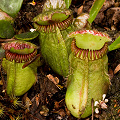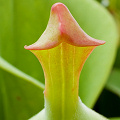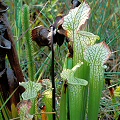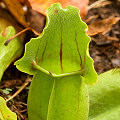Q: Exactly how do these plants capture prey? Answer #1--pitfall traps
A: The simplest kind of trap that carnivorous plants use is the pitfall trap, or
pitcher trap.
This trap is really easy to understand. It is simply a pit into which prey fall, and once inside they cannot escape. How do
they die? The bottom of the pit is filled with fluid--perhaps rainwater or fluid produced by the plants. The prey eventually
drowns and then sinks to the bottom of the pit. There, the carcass is digested by enzymes (if the plant produces them), bacterial
action, or other small organisms.
It is easy to imagine this kind of trap evolving. If a flat leaf curled, so its outer edges came into contact with each other and
sealed, you have a pitcher. This kind of leaf structure occurs from time to time in noncarnivorous plants
Take a look at the probably non-carnivorous leaves of
Dipsacus to see this kind of character in action. If a plant living
in nutrient poor conditions evolved this character randomly, and started capturing prey, there would a big benefit to it.
It sounds pretty simple, doesn't it? But there are many refinements to this trap that can make it much more efficient.
For example, if the plant produced sweet necter around the pitcher mouth, prey would be tempted to explore the oh-so-dangerous
edges of the pit. The walls of some pitchers are exceedingly slippery, or have downward-pointing hairs. The pitchers are also
brightly colored, perhaps mimicking flowers. Some pitcher plants produce an odor that may be attractive, too. Furthermore, the pitcher
fluids of some species have interesting, sticky-slimy properties. These viscoelastic fluids help capture and retain prey.
Many pitchers have lids other their pitcher mouths. These lids do not slam down on prey! The lids instead serve at least three
purposes. First, they help keep unwanted rain out of the pitchers---too much rain would result in the pitchers toppling over.
Second, they act as convenient landing pads for bugs. Third, and in my opinion the most important, they merely provide a structure
over the mouth of the pitcher where the plant can produce lots of nectar. Insects feasting upon the large amounts of nectar on
the underside of the lid are in great danger of plummeting to their doom. The photograph of
Heliamphora tatei above shows the little lid over the pitchers, often called a nectar spoon, because
it produces tasty sugary secretions just over the death trap.
Page citations: Gaume, L., & Forterre, Y. 2007;
Lloyd, F.E. 1942; Rice, B.A. 2006a.



